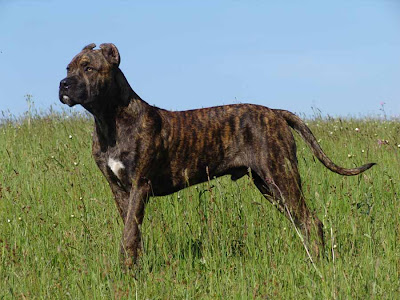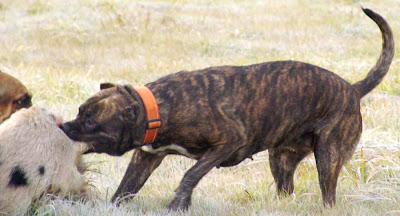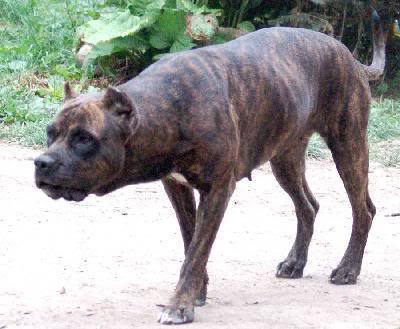In all of these disciplines, the Spanish Alano counts on his most notorious characteristic, its strong bite. The mouth gripping of the Spanish Alano is known and admired since the ancient times. The Spanish Alano bites with the whole mouth, even with its molars. Its bite is fixed very firmly and it is hold for a long period of time. The temperament is very serious and self secure, watching the strangers. The mouth gripping in wild or half wild animals is focused into selected areas, like ears, neck and snout (the snout, specially when hunting). His psychological development is slow, not reaching maturity until the two years of age.
Until that age the dog can show himself insecure and it is not advisable to force his temperament. When maturity is reached, he won't be afraid of anything, reacting with self security if menaced. With his master, he is submissive and receptive to learn. His distrust towards the stranger makes him an excellent dog of guard and defense, psychologically very stable and tranquil. Traditionally, the Spanish Alano has been used in three basic functions:
1) Bovine cattle management
2) Big game hunting
3) Guard and defense
HEAD: Brachycephallic constitution, cubical shape, large and powerful not reaching the point where it looks massive. Cranium/face ratio of 63/37. Its skin should be straight, not wrinkly , except for the wrinkles formed in between the ears when the dog is alert.
CRANIUM: Of a convex profile, flat between the ears, wide and strong, with prominent and rounded frontal sinuses. It shows a depression between the eyes which follows thru half way over the cranium. Very well marked stop. Temporal muscles very well developed, the occipital crest is unseen due to the great muscular development, well developed jaw muscles, but never exaggeratedly developed. Prominent zigomatical arches. The cranium-facial lines must run parallel to each other, being a very slight convergence allowed, although this is not desirable. They must never diverge.
MUZZLE: Shorter than the cranium, looking square, very wide and deep, it normally represents 37% of the total length of the head, a shorter muzzle is allowed as long as it is not under a 35% of the total length of the head. It must not show any wrinkles nor folds.
DEWLAPS: Moderately thick, the upper dewlap hangs slightly and covers the lower one, the former being practically unseen when the mouth is closed. Pigmentation must always be black.
EYES: Of a medium size, separated between each other, rounded. They are light brown, amber or yellow, depending on the coat coloration. Eye lids are adhered to the eyes and they are remarkably pigmented in black. The serious expression and the penetrating look is characteristic in the breed, individuals with a sweet and melancholic look not being desirable.
EARS: Of a medium insertion, very separated between each other, normally cropped from their base. When cropped, they are slightly rounded and pointy, small in size. When not cropped they are folded over the face and medium in size.
MAXILLARIES: Well developed. Strong and healthy dentition, the incisive teeth must be large and correctly aligned, canine teeth must be short and wide, very separated from each other. The ideal bite is the so called inverted scissors bite, the external face of the upper, incisive teeth touch the internal face of the lower incisive teeth. The chin is wide and strong, easily seeable when looking frontward, it must not be ingoing nor outgoing.
NOSTRIL: Very large, wide, with well opened nasal orifices. Always pigmented in black.
NECK: Very strong, of a cylindrical structure, relatively short and wide. The skin, somewhat looser than in the rest of the body, forms a slight double chin that will never become exaggerated.
TRUNK: Normally, its length outgoes the height at the withers by a 10% or a 12%.
BACKBONE LINE: Straight or slightly ascending, never descending.
WITHERS: Defined, of a medium insertion, in a descending line towards the backbone. Wide, long and strongly muscled.
UPPER BODY: Straight, muscled. The lumbar area must be relatively long, wide and of a strong musculature.
BACK END: Wide, strong and slightly fallen.
TAIL: Of a medium insertion, thick in its base it thins out progressively until its end. Its length goes until the hocks. In action it is carried up with arching it slightly towards the back not becoming rolled in. The hair can be some more dense than in the rest of the body, not forming fringes.
THORAX: Ribs area is arched out, not cylindrical, looking at it sideways the chest reaches the elbows. The thoracic perimeter is approximately the same as the height at the withers plus a 25% more than the former. The chest is medium in width, deep, very muscled. The internal chest width, between the front legs' insertion, is equivalent to a 28% or a 30% of the height at the withers.
LOWER PROFILE LINE: Looking at it sideways, the thorax presents a line that, gradually, ascends towards the abdomen. The belly must retract inwards, but never become like that of a Greyhound's.
BACK: Long, wide and oblique. It is provided of a strong musculature. The scapular humeral angle is of about 100°















0 comments:
Post a Comment